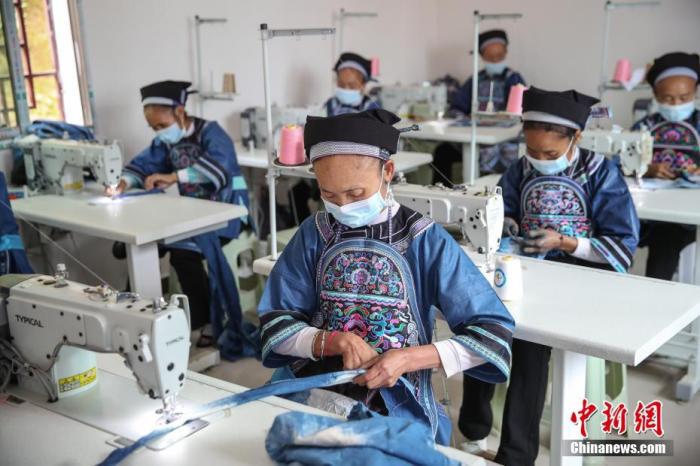China News Service, December 16th. Liu Huanxin, Vice Minister of Agriculture and Rural Affairs, introduced today that industrial poverty alleviation policies have covered 98% of poor households, and poor people with the ability and willingness to work are basically involved in industrial poverty alleviation.
With the strong support of industrial poverty alleviation, the per capita net income of poor households increased from 3,416 yuan in 2015 to 9,808 yuan in 2019, an average annual increase of 30.2%.
Data map: Workers process products in a poverty alleviation workshop.
Photo by China News Agency reporter Qu Honglun
The State Council Information Office held a press conference on the 16th. Vice Minister Liu Huanxin of the Ministry of Agriculture and Rural Affairs introduced the progress of industrial poverty alleviation and answered questions from reporters.
Liu Huanxin pointed out that in recent years, the Ministry of Agriculture and Rural Affairs has taken the lead in working with relevant departments to fully implement the central government’s poverty alleviation decision-making and deployment, issued guidelines for industrial poverty alleviation, insisted on planning and leadership, focused on the promotion of examples, strengthened supervision and assessment, and promoted major achievements in industrial poverty alleviation work in various regions.
One is the rapid development of characteristic industries in poor areas.
All 832 poverty-stricken counties have formulated industrial poverty alleviation plans, and accumulated more than 300,000 industrial bases for planting, breeding, processing, etc., and new models and new formats such as tourism poverty alleviation, photovoltaic poverty alleviation, and e-commerce poverty alleviation have been accelerated, and each poor county has formed 2-3 leading poverty alleviation industries with distinctive characteristics and a wide range of poverty areas have been established.
Especially in deeply impoverished areas such as "Three Districts and Three States", many poor villages have realized the historical leap of characteristic industries "from scratch", and a number of nationally renowned characteristic brands such as Liangshan pepper, Nujiang grass fruit, Linxia cattle and sheep have emerged. .
Second, the income level of the poor has increased substantially.
Industrial poverty alleviation policies have covered 98% of poor households, and poor people with the ability and willingness to work have basically participated in industrial poverty alleviation.
Among them, the poor households directly involved in planting, breeding, and processing industries are 11.58 million, 9.35 million, and 1.68 million, respectively; more than 13 million poor laborers work in rural enterprises and poverty alleviation workshops in the county, accounting for the total number of migrant workers. Nearly half the number.
With the strong support of industrial poverty alleviation, the per capita net income of poor households increased from 3,416 yuan in 2015 to 9,808 yuan in 2019, an average annual increase of 30.2%.
Third, the conditions for industrial development in poor areas have improved significantly.
The rapid development of the poverty alleviation industry has provided a platform for capital, technology, talent and other factors to enter poverty-stricken areas, and has also accelerated the construction of supporting facilities such as transportation, logistics, and communications.
According to statistics, poverty-stricken counties have built 210 million mu of high-standard farmland, 43,000 primary processing facilities for agricultural products, cultivated 14,400 leading enterprises above the city level, developed 719,000 farmer cooperatives, and created more than 2,100 various poverty alleviation industrial parks. More than 4,100 industrial technical expert groups have recruited more than 4,000 specially-appointed agricultural technicians. The industrial development guarantee in poor areas has become stronger and the stamina has been significantly enhanced.
Fourth, the self-development capabilities of the poor have been significantly improved.
Through industrial poverty alleviation, not only has it formed a series of effective models of industry-linked agriculture to promote poverty, but also inspired the poor people’s mental state of being unreliable, self-improving, and changing their lives with diligent hands. These will continue to promote the overall revitalization of the countryside in the future. Play a role.
Relying on order-to-order production, land circulation, production custody, on-site labor, share cooperation, asset leasing, etc., 72% of poor households have established a close interest connection relationship with the new agricultural business entity.
Through industrial empowerment, more than 70% of poor households have received production guidance and technical training, and more than 900,000 people have been trained to become wealthy leaders in various industries. The effect of industrial poverty alleviation is very obvious.
Liu Huanxin said that industrial poverty alleviation has become the most extensive, most sustainable and sustainable poverty alleviation measure.
These achievements are the result of the scientific decision-making and strong leadership of the Party Central Committee, the result of the hard work and unremitting efforts of the poor people and the vast number of poverty alleviation cadres, and the result of the united efforts of the whole party and society.
"Consolidating and expanding the results of poverty alleviation and the effective connection of rural revitalization. The development of industries is the most direct link and an important pillar. It not only supports the prevention of poverty, but also supports the comprehensive revitalization of the countryside." Liu Huanxin said, "Next, we will follow the party’s nineteenth The Fifth Plenary Session of the Central Committee of the Communist Party of China made arrangements to further improve industrial assistance policies and measures, and focus on promoting the transformation of characteristic industries in poverty-stricken areas from rapid coverage to long-term cultivation. The cultivation link is expanding and transforming to the entire industry chain, promoting the continuous development and growth of characteristic industries, upgrading and upgrading, improving quality, efficiency and competitiveness, and providing solid and strong support for consolidating the results of poverty alleviation and promoting the comprehensive revitalization of rural areas."

